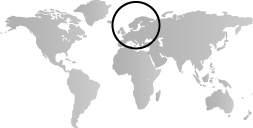The seventeenth century marks a turning point for the powers of Eastern Europe and Scandinavia. Denmark, long the leader in the region, loses its dominance to Sweden and Russia, which in turn engage in a series of wars over land and ports in the Baltic. Although Sweden triumphs initially, Russia later wins out, gaining territory extending from Finland to Lithuania. In the eighteenth century, Russia also expands on its southern and western borders at the expense of the ever-weaker Polish Republic and Ottoman empire. A peripheral force before 1600, by 1800 Russia becomes one of the world’s great powers.
Great personalities and continual warfare dominate the region throughout the seventeenth and eighteenth centuries. Mighty autocrats demonstrate their sovereignty in military campaigns and ambitious programs of patronage. Artists design and decorate weapons and fortresses as well as palaces, gardens, paintings, and sculpture. Many of the artists working in Eastern Europe and Scandinavia travel there from Germany, Italy, and France at the invitation of royal patrons and, as a result, shifts in style and taste reflect artistic currents in western Europe. The Dutch and German Baroque prevail in the early seventeenth century; later, Italian Baroque influences are definitive. In the eighteenth century, the French court becomes the primary source of inspiration for monumental projects, and by 1800 Neoclassical design is favored for architecture and interiors as well as in painting and sculpture. The founding of royal academies in the eighteenth century provides for the training of artists in the several nations.


